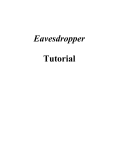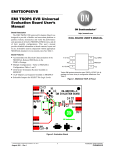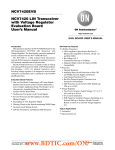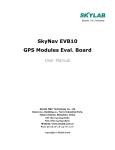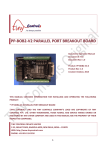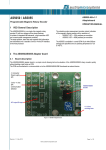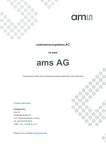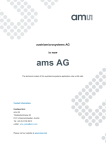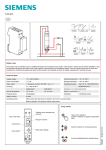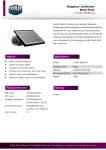Download NCP2824FCT2 Evaluation Board User`s Manual
Transcript
NCP2824FCT2GEVB NCP2824FCT2 Evaluation Board User's Manual http://onsemi.com EVAL BOARD USER’S MANUAL Overview The NCP2824 is a Filterless Class D amplifier capable of delivering up to 2.4 W to a 4 W load with a 5 V supply voltage. With the same battery voltage, it can deliver 1.2 W to an 8 W load with less than 1% THD+N. The Non-clipping function adjusts automatically the output voltage in order to control the distortion when an excessive input is applied to the amplifier. This adjustment is done thanks to an Automatic Gain Control circuitry (AGC) built-in the chip. A simple Single wire interface allows to enable/disable the non Clipping function and also to configure the maximum distortion level in the output. A programmable power limit function is also embedded in order to protect speakers from damage caused by an excessive sound level. The intent of the evaluation boards is to illustrate typical operation of the NCP2824 device for laboratory characterization. The NCP2824FCT2GEVB schematic is depicted in Figure 2. Figure 1. NCP2824FCT2GEVB Board Picture © Semiconductor Components Industries, LLC, 2012 May, 2012 − Rev. 2 1 Publication Order Number: EVBUM2110/D NCP2824FCT2GEVB BOARD SCHEMATIC J14CON2 2 3 100n 2 CNTL OUTM NCP2824 B1 Vdd ÎÎ ÎÎ ÎÎ ÎÎ 1 1 1 1 1 J10 TP 1.0D A3 OUTP C3 OUTN 1 1 CNTL AGND ÎÎ ÎÎ 1 OUTP INM C2 J8 TP 1.0D 3 1 1 1 1 INP C1 C6 4.7μF 0 1 A1 VDD 2 1 1 2 C2 INMF 0 J1 1 U1 NC 1 A2 J5 C3 4.7μF 0 1 ÎÎÎ Î ÎÎ BOARD FIXATION HOLES 1 Vdd J11 TP 1.0D J15 2 1 2 1 CON2 SPEAKER CONNECTION 1 Jumper2 ÎÎ ÎÎ 100μF−NC B2 ÎÎ ÎÎ 0 1 2 2 0 100n 1 1 1 J19 0 J9 TP 1.0D C5 2 CUT H J7 TP 1.0D J2 2 C1 2 Jumper2 1 PGND 1 B3 1 2 ÎÎ J4 1 1 J18 FIX 3.2 H FIX 3.2 H FIX 3.2 H FIX 3.2 H CUT H INPF 1 J17 1 2 J6 TP 1.0D J3 1 2 ÎÎ ÎÎ J16 POWER SUPPLY Jumper3 0 C4 NC 0 0 ÎÎÎÎ ÎÎ ÎÎÎÎ ÎÎ J12 J13 1 ENABLE− SINGLE WIRE 0 0 1 2 2 1 GND 1 TP 1.0D 0 Title NCP2824 EVB Size Document Number CustomNCP2824 EVB TLS−P−001−A−0310−DR Date: Figure 2. NCP2824FCT2GEVB Evaluation Board Schematic http://onsemi.com 2 Sheet Rev 1 of 1 NCP2824FCT2GEVB OPERATION The operating power supply of the NCP2824 is from 2.5 to 5.5 V. The absolute maximum input voltage is 7.0 V. A power supply set to 3.6 V and current limit set to at least 1.5 A must be connected to J14 connector to powering the NCP2824EVB/D. Also to compensate for parasitic inductance of wires between the power supply and the evaluation board it is highly recommended to connect a 470 mF electrolytic capacitor to bypass J14 terminal. Like this the device can be evaluated under powering condition very similar that battery power supplies. Table 1. NCP2824 CONFIGURATION Pulse Counting Register Description 01 AGC AGC disable 02 03 Reset Reset configuration 04 Gain Control Gain = 12 dB THD Control 1% 05 06 Performances of EVB Solution 07 To be as close as possible with final handset application, the design of this power conversion solution used small size footprints where possible. Changing components may positively or negatively impact the evaluation board performance illustrated in Figure 3 to 8. For more information please refer to the NCP2824 datasheet. Single Wire Interface Operation The single wire interface allows changing the default configuration of the NCP2824. After Wake up, the NCP2824 is configured with: • AGC enable • Non Clip + Power limit • Gain = 18 dB • THD max = 1% Gain = 18 dB 2% 08 4% 09 6% 10 8% 11 10% 12 15% 13 20% 14 NC+L Non Clip + Power limit 15 NC Non Clip only 16 Power Limit Control 0.45 VPeak 17 18 The following table described all the NCP2824 configurations. AGC Enable 0.9 VPeak 1.35 VPeak 19 1.8 VPeak 20 2.25 VPeak 21 2.7 VPeak 22 3.15 VPeak 23 3.6 VPeak Single Wire commands can easily be emulated using a pulse generator configured in accordance with the Single wire specification, for more information about timings please refers to NCP2824 datasheet. http://onsemi.com 3 NCP2824FCT2GEVB Table 2. BOARD CONNECTIONS INPUT POWER Symbol Descriptions J14−1 This is the positive connection for power supply. The leads (positive + ground) to the input supply should be twisted and kept as short as possible. J14−2 This is the return connection for the power supply (Ground signal) J13 Ground clip AUDIO Descriptions Symbol J3 Positive Audio input J2 Negative Audio input J15−2 Positive Audio output J15−1 Negative Audio output SWITCHES SETUP Switch Descriptions Symbol J1 Enable J4 Short input capacitor on positive input J5 Short input capacitor on negative input J2 Connect the positive audio input to Gnd J3 Connect the negative audio input to Gnd TEST POINT Switch Descriptions Symbol J12 This test point is directly connected to the GND J9 This test point is directly connected to the Vdd pin J6 This test point is connected to the positive audio input J7 This test point is connected to the negative audio input J10 This test point is connected to the positive audio output J11 This test point is connected to the negative audio output http://onsemi.com 4 NCP2824FCT2GEVB TYPICAL OPERATING CHARACTERISTICS THD+N vs Pout @ 255C THD+N vs Pout @ 25°C Vdd=2.5V Vdd=2.7V Vdd=3V Vdd=3.6V Vdd=4.2V Vdd=5V Vdd=5.5V Vdd=2.5V 10 10 THD (%) 100 THD (%) 100 1 0.1 Vdd=2.7V Vdd=3V Vdd=3.6V Vdd=4.2V Vdd=5V Vdd=5.5V 1 0.1 0.01 10 100 1000 0.01 10 10000 Pout (mW) 100 1000 10000 Pout (mW) Figure 3. THD vs. POUT, RI = 8 W, f = 1 kHz Figure 4. THD vs. POUT, RI = 4 W, f = 1 kHz THD ve rsus Fre que ncy @ Vdd=3.6V Eff vs Pout @ Vdd=3.6V RL = 8 W 100 Pout=250mW 10 Pout=500mW 90 80 1 THD+N (%) 70 (%) 60 50 0.1 40 30 0.01 20 10 0.001 0 10 0 200 400 600 Pout (mW) 800 100 1000 1000 10000 100000 Freq (Hz) Figure 5. Efficiency vs. POUT, RI = 8 W, f = 1 kHz Figure 6. THD vs. Frequency, RI = 8 W, POUT = 250 mW PSRR vs Frequency (Inputs grounded, Gain = 12 dB, Cin = 1 mF) P e a k vol ta ge vs. V i n for V DD= 5V Vdd=3V 4.0 Vpeak Target=0.45V Vpeak Target=2.25V Vdd=3.6V Vdd=5V 0 Temp=25 5C Vpeak Target=0.9V Vpeak Target=2.7V Vpeak Target=1.35V Vpeak Target=3.15V Vpeak Target=1.8V Vpeak Target=3.6V −10 −20 3.0 −30 PSRR (dB) 3.5 (V) 2.5 2.0 −40 −50 1.5 −60 1.0 −70 0.5 0.0 0.0 −80 0.2 0.4 0.6 0.8 1.0 10 1.2 Vin(V) 100 1000 10000 Freq (Hz) Figure 7. Peak Output Voltage in Power Limit vs. Input Voltage (rms) and Power Limit Settings, Av = 12 dB Figure 8. PSRR vs. Frequency http://onsemi.com 5 100000 NCP2824FCT2GEVB PCB LAYOUT Figure 11 show the layout of the NCP2824FCT2GEVB board. For more specific layout guidelines please refer to the NCP2824 datasheet. As with all Class D amplifiers, care must be observed to place the components on the PCB and layout the critical nodes. The evaluation board is made of 4 PCB layers where first internal layer is a GND. Figure 9, Figure 10 and Figure 9. Assembly Layer TOP Figure 10. Top Layer Routing http://onsemi.com 6 NCP2824FCT2GEVB Figure 11. Bottom Layer Routing Table 3. BILL OF MATERIALS Qty Ref Des. Description Size Manufacturer Part Number 1 U1 NCP2824 CSP−9 1.45 x 1.45 mm ON Semiconductor NCP2824 2 C1, C2 Capacitor, Ceramic 100 nF 0603 KEMET C0603C104K5RAC 2 C3, C6 Capacitor, Ceramic 4.7 mF 6.3 V 0603 KEMET C0603C475K9PAC 2 J14, J15 Mal. SL5.08/2/90B plus Fem. BLZ 5.08/2 Weidmuller SL5.08/2/90 + BLZ 5.08/2 3 J1 Header 3 pin, 100 mil spacing 0.100 x 2 Std Std 2 J2, J3 Header 2 pin, 100 mil spacing 0.100 x 2 Std Std 1 J6 GND Connection Std Std 9 J6, J7, J9, J10, J11, J12, J13 Test Point Std Std 2 J4, J5 Soldering point must be connected 1 PCB PCB 2.0 in x 2.0 in x 1.0 mm, 4 Layers Any TLS−P−001−A−0310−RD NOTE: C3 is not mounted ON Semiconductor and are registered trademarks of Semiconductor Components Industries, LLC (SCILLC). SCILLC reserves the right to make changes without further notice to any products herein. SCILLC makes no warranty, representation or guarantee regarding the suitability of its products for any particular purpose, nor does SCILLC assume any liability arising out of the application or use of any product or circuit, and specifically disclaims any and all liability, including without limitation special, consequential or incidental damages. “Typical” parameters which may be provided in SCILLC data sheets and/or specifications can and do vary in different applications and actual performance may vary over time. All operating parameters, including “Typicals” must be validated for each customer application by customer’s technical experts. SCILLC does not convey any license under its patent rights nor the rights of others. SCILLC products are not designed, intended, or authorized for use as components in systems intended for surgical implant into the body, or other applications intended to support or sustain life, or for any other application in which the failure of the SCILLC product could create a situation where personal injury or death may occur. Should Buyer purchase or use SCILLC products for any such unintended or unauthorized application, Buyer shall indemnify and hold SCILLC and its officers, employees, subsidiaries, affiliates, and distributors harmless against all claims, costs, damages, and expenses, and reasonable attorney fees arising out of, directly or indirectly, any claim of personal injury or death associated with such unintended or unauthorized use, even if such claim alleges that SCILLC was negligent regarding the design or manufacture of the part. SCILLC is an Equal Opportunity/Affirmative Action Employer. This literature is subject to all applicable copyright laws and is not for resale in any manner. PUBLICATION ORDERING INFORMATION LITERATURE FULFILLMENT: Literature Distribution Center for ON Semiconductor P.O. Box 5163, Denver, Colorado 80217 USA Phone: 303−675−2175 or 800−344−3860 Toll Free USA/Canada Fax: 303−675−2176 or 800−344−3867 Toll Free USA/Canada Email: [email protected] N. American Technical Support: 800−282−9855 Toll Free USA/Canada Europe, Middle East and Africa Technical Support: Phone: 421 33 790 2910 Japan Customer Focus Center Phone: 81−3−5817−1050 http://onsemi.com 7 ON Semiconductor Website: www.onsemi.com Order Literature: http://www.onsemi.com/orderlit For additional information, please contact your local Sales Representative EVBUM2110/D








